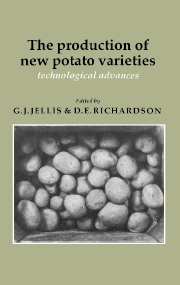Book contents
- Frontmatter
- Contents
- List of contributors
- Preface
- Editors' note and acknowledgements
- Introduction
- The development of potato varieties in Europe
- Genetic Resources
- Breeding Strategies
- Selection and Screening Methods
- Variety Assessment
- Semi-conventional Breeding Methods
- Efficient utilization of wild and primitive species in potato breeding
- Advances and limitations in the utilization of Neotuberosum in potato breeding
- Breeding at the 2x level and sexual polyploidization
- Haploids extracted from four European potato varieties
- Heterosis for tuber yields and total solids content in 4x x 2x FDR-CO crosses
- Variability of F1 progeny derived from interploidy (4x x 2x) crossing
- Unreduced gametes in the breeding of potatoes at the diploid level
- Desynapsis and FDR 2n-egg formation in potato: its significance to the experimental induction of diplosporic apomixis in potato
- Utilizing wild potato species via Solanum phureja crosses
- The use of diploid Solanum phureja germplasm
- Advances in population breeding and its potential impact on the efficiency of breeding potatoes for developing countries
- True Potato Seed
- Unconventional Breeding Methods
- Commentary
- Index
Heterosis for tuber yields and total solids content in 4x x 2x FDR-CO crosses
Published online by Cambridge University Press: 05 March 2012
- Frontmatter
- Contents
- List of contributors
- Preface
- Editors' note and acknowledgements
- Introduction
- The development of potato varieties in Europe
- Genetic Resources
- Breeding Strategies
- Selection and Screening Methods
- Variety Assessment
- Semi-conventional Breeding Methods
- Efficient utilization of wild and primitive species in potato breeding
- Advances and limitations in the utilization of Neotuberosum in potato breeding
- Breeding at the 2x level and sexual polyploidization
- Haploids extracted from four European potato varieties
- Heterosis for tuber yields and total solids content in 4x x 2x FDR-CO crosses
- Variability of F1 progeny derived from interploidy (4x x 2x) crossing
- Unreduced gametes in the breeding of potatoes at the diploid level
- Desynapsis and FDR 2n-egg formation in potato: its significance to the experimental induction of diplosporic apomixis in potato
- Utilizing wild potato species via Solanum phureja crosses
- The use of diploid Solanum phureja germplasm
- Advances in population breeding and its potential impact on the efficiency of breeding potatoes for developing countries
- True Potato Seed
- Unconventional Breeding Methods
- Commentary
- Index
Summary
INTRODUCTION
Peloquin (1982) proposed five breeding schemes for the utilization of primitive cultivars and wild relatives of the potato, Solanum tuberosum ssp. tuberosum (Tuberosum) (2n = 4x = 48). Of these breeding schemes, 4x x 2x crosses (unilateral sexual tetraploidization), using diploids which produce 2n gametes, allow the breeder to obtain almost entirely 4x progenies, due to the strong triploid block existing in potato and its wild relatives (Johnston et. al. 1980).
Tetraploid offspring with high tuber yields, good vine vigour and significant heterosis have been reported from 4x x 2x crosses (Hanneman & Peloquin 1969; Mok & Peloquin 1975; Kidane-Mariam & Peloquin 1974; 1975; Mendiburu & Peloquin 1977; De Jong & Tai 1977; De Jong et al. 1981; McHale & Lauer 1981; Schroeder 1983). In their crosses the 2x clones, used as males, produced 2n pollen by first division restitution (FDR).
This paper presents results obtained from 4x progenies of 4x x 2x FDR crosses. The experiment was carried out in France during 1983 and three major economic traits were studied: total tuber yield, marketable tuber yield and total solids.
MATERIALS AND METHODS
During the spring of 1981, 4x x 2x crosses were made in the glasshouses of the GIE Germicopa Recherche et Création, at Chateauneuf du Faou, France. Six European cultivars (2n = 4x = 48) - Claustar, Spunta, BF 15, Sirtema, Charlotte and Desiree - were used as seed parents. US-W 5295.7 and five progeny clones of US-W 5295.7 x US-W 5337.3 from the University of Wisconsin potato programme were used as male parents.
- Type
- Chapter
- Information
- The Production of New Potato VarietiesTechnological Advances, pp. 213 - 217Publisher: Cambridge University PressPrint publication year: 1987
- 12
- Cited by

